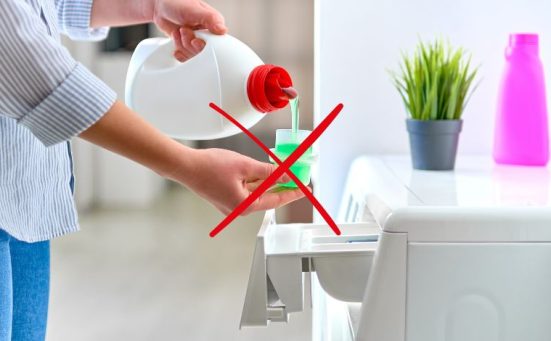
Washing Machine Jumping? (here’s why)
If your washing machine is jumping and bouncing around it can be worrying, but in some cases, it has an easy fix. Keep reading to find out what could be causing your washing machine to jump around and more importantly, how to stop it.
The most common cause of a washing machine jumping is an unbalanced load
New Machines
If you have just installed a new washing machine and it is jumping around during its first use there are several things you need to check. Firstly, we would suggest switching your machine off to save doing any damage to it.
Check That The Transit Bolt Has Been Removed
To ensure that nothing internally gets damaged on the machine during transportation to your home, manufacturers fit a transit bolt into the machine. This should be removed during installation into your home. If you installed the machine yourself, it’s possible that you omitted to remove the transit bolt.
If the machine can’t bounce up and down on its suspension, it will jump around and can do so quite violently. Check your user manual for how to correctly remove the transit packaging.
Check That The Machine Is Level
If all of the transit packaging has been correctly removed and the machine is still jumping, it’s probably because the floor is uneven or the machine has been positioned unevenly. On each corner of the machine are adjustable feet, using a spirit level, determine whether your washing machine is level or not. Adjust each foot accordingly until the machine is level.
Uneven Load
If the feet are level and you still have a jumping washing machine, it’s likely you have placed an uneven load into the machine. In fact, this is the most common reason that washing machines jump. It might be common, but it still needs dealing with, because left unchecked, your machine could get damaged.
There are two main causes of an uneven load in a washing machine which are;
- Overloading
- Underloading
Cramming too much laundry into the drum can cause the load to be uneven which will cause the machine to jump around. Conversely, not putting enough laundry into the machine will cause the same problem. Too little laundry and it will all cling to one side of the drum which will cause the machine to jump.
Many modern machines have load sensors which will pick up on both of these issues and in many cases stop the machine from functioning. This will result in your washing still being dirty when you return to the machine.
To check if the load is uneven, watch the machine before it starts a spin cycle. If the load is uneven you will see the inner drum wobbling from side to side. If this wobble is too violent, this is when the sensors can stop the machine.

Drain Pump Blocked
If the jumping around and noise happens during the drain cycle it could be something as simple as the drain pump filter has a blockage. You can inspect and clear the pump filter quite easily.
At the bottom front of your washing machine, you will find a plastic twist screw, place a bowl beneath this screw before undoing it as there will be some water which will escape as soon as the screw is removed. Inspect the filter and remove any dirt or gunge using tap water.
Whilst the filter is removed, clean any foreign bodies like screws, pins, nails, buttons etc from the filter housing, and then gently turn the impeller inside the pump with your finger to ensure the pump is working correctly. It is then just a case of replacing the filter and tightening it back into position.
Washing Machine Making Loud Bangs And Jumping
This would allude to a problem which is difficult to isolate as many faults can produce these same results. If you’re sure it’s none of the above issues it could be any one of the following;
- Motor Fault
- Control Board Fault
- Shock Absorber Fault
- Suspension Spring Fault
- Drum Bearing Fault
- Or More
In any case, if your washing machine is displaying symptoms which could allude to any of the faults we’ve highlighted, we recommend contacting a washing machine engineer to correctly diagnose and repair your machine.
Too Much Vibration Due To Floor Surface
This is a problem usually experienced by those of you with washing machines fitted on unsolid floors. Wooden floors for example are often the cause of the washing machine vibrating excessively which causes it to jump.
You can help to absorb some of that extra vibration by placing anti-vibration pads under each foot of your washing machine. These rubber pads are placed on the floor and the washing machine’s feet are placed into the pad.
The thick rubber pad absorbs the vibration from the machine and prevents it from moving around. They are available for around £10 for a set of four, one for each foot.
It should be stressed here that these pads are not going to prevent any internal causes for the machine jumping, they are strictly used to correct the bouncy floor surface.
Frequently Asked Questions
The most common cause of your washing machine jumping around is an uneven machine. The ground is probably not 100% flat. You will need to adjust the feet on your machine until it is level (use a spirit level). If your machine is not on a concrete floor it might need anti-vibration pads to counteract the floor’s movement. Or it could just be the machine has an uneven wash load.
If your washing machine is shaking violently, it could be because it is overloaded or even underloaded. The reason could be because the wash load is all sitting on one side of the drum which makes the drum spin unevenly. Or the machine needs levelling by adjusting the feet.
The most common reason for a washing machine banging and moving is an uneven load. If all of the laundry has gone to one side of the drum it will make the drum rotate off balance. Or it could be the machine has not been levelled when it was installed. The feet are adjustable and should be used in conjunction with a spirit level to ensure the machine is 100% level.
Also, follow us on Pinterest ...



